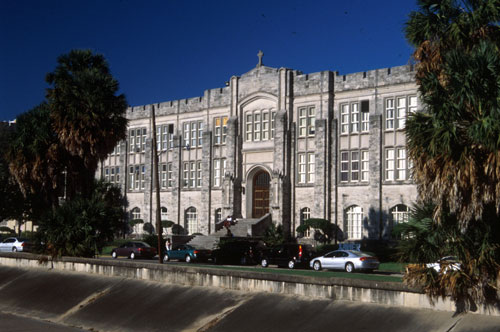Xavier University
Xavier University in New Orleans is the only historically black Catholic university in the United States.

Courtesy of Louisiana Department of Culture, Recreation & Tourism.
n 1933 Xavier University's Gothic style Administration Building was completed. It is now a New Orleans city landmark.
As the only historically black Catholic university in the United States, Xavier University is renowned for the high percentage of African American students it places in medical schools throughout the country. In 1891 Katharine Drexel (1858–1955), daughter of Philadelphia multimillionaire financier–banker Francis Drexel, founded the Sisters of the Blessed Sacrament, an order dedicated to educational and charitable work among America’s minorities. Saint Katharine (she was canonized in 2000) established a high school in New Orleans in 1915 and named it for the Spanish Jesuit missionary Saint Francis Xavier; in 1917 she added a two-year normal school for training black teachers. Xavier became a four-year liberal arts university in 1925 and opened a college of pharmacy in 1927.
Xavier University was first located at 5100 Magazine Street, a site now occupied by Xavier Preparatory High School for girls. The modern campus began to take shape in 1932, when the university moved to the corner of Palmetto and Pine Streets in the city’s Gert Town neighborhood. The architectural firm of Wogan and Bernard designed the Indiana limestone administration building, with its two wings—one a science building, the other a convent for the sisters—in the neo-Gothic style of many collegiate structures. When Pope John Paul II visited New Orleans in 1987, he addressed presidents of US Catholic colleges in the administration building’s courtyard. A library (now the music building) was added in 1937. Expansion in the 1960s added more buildings, and the enormous success and growth of Xavier’s pharmacy and premedical programs in the 1990s spurred further growth. Xavier now comprises roughly forty buildings in a multi-block area and serves approximately 3,500 students.
On an unprepossessing site adjacent to a freeway overpass, the campus has also grown vertically, with buildings in expressive forms and colorful materials that challenge their difficult setting. The six-story Library and Resource Center of 1996, by Blitch/Knevel and Billes/Manning, was joined in 1998 by the Norman C. Francis Science Academic Complex, named for the university’s longtime president and designed by Sizeler Architects. The latter structure—a sharply angled composition with a tower, bay windows, pinnacled piers, a prow like corner, and arched entrances—has a castle-like quality that fits in with the university’s original neo-Gothic building. All of the new buildings have green roofs, Xavier’s modern signature.
In the twenty-first century continuing expansion and the ravages of Hurricane Katrina further altered the campus landscape. The University Center and St. Martin Deporres Residence Hall opened in 2004, and the Qatar Pharmacy Pavilion was added in 2010. Between 2011 and 2013 Xavier erected several new structures. Among them were the Art Village, a group of former industrial buildings converted by Manning Architects into an expanded center for art programs, and a 4,500-seat Convocation Center that houses a basketball arena. Renowned international architect César Pelli designed the St. Katharine Drexel Chapel, which opened in 2012. The octagonal chapel, which seats 450, is faced in smooth limestone and crowned by an angled copper roof (which in time will acquire a green patina) with skylights to illuminate the spacious interior. Cuban-born artist José Bedia created the fourteen modernist stained-glass windows that depict the Stations of the Cross. The 1940s-era gymnasium known as the Barn and the vintage dormitory known as the House of Studies were torn down in 2013.
Adapted from Karen Kingsley’s Buildings of Louisiana, part of the Buildings of the United States series commissioned by the Society of Architectural Historians (www.sah.org) and published by Oxford University Press.
